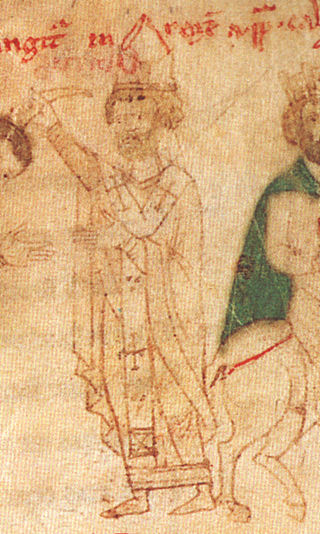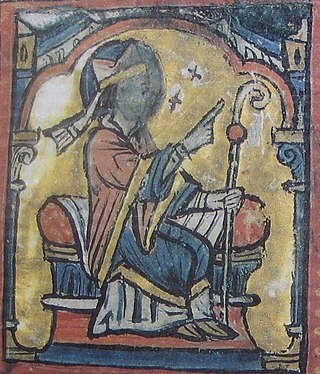Theodoric was an antipope in 1100 and 1101, in the schism that began with Wibert of Ravenna in 1080, in opposition to the excesses of Pope Gregory VII and in support of the Emperor Henry IV.
Victor IV was an antipope for a short time, from March to 29 May 1138.
Pandulf of Pisa was a twelfth-century Italian cardinal, and biographer of several contemporary popes. He was a native of Rome. He was a nephew of Cardinal Hugo of Alatri. Under Pope Paschal II, and probably with the patronage of his uncle, Pandulf held the post of ostiarius at the papal court. It is deduced from his detailed description of the election of Pope Gelasius II on 24 January 1118 that he was present. On his coronation day, 10 March 1118, Pope Gelasius II elevated him to the rank of Lector and Exorcist. Pope Calixtus II ordained him a subdeacon.

The 1119 papal election was, of all the elections currently considered legitimate by the Roman Catholic Church, the smallest papal election of the twelfth century.
The October 1187 papal election was convoked after the death of Pope Urban III. He and the papal court had escaped from the imperial blockade of Verona only the month before, and had taken refuge in Ferrara. The election, held in Ferrara the day after the pope's death, resulted in the election of Cardinal Alberto Sartori di Morra, who took the name of Gregory VIII. He was a partisan of the Emperor Frederick Barbarossa, whose election delighted him. Gregory VIII reigned only two months.

The December 1187 papal election was convoked after the death of Pope Gregory VIII. It resulted in the election of Cardinal Paolo Scolari, who took the name of Clement III.
Oderisio di Sangro was an Italian Benedictine monk and cardinal, the son of Count Rinaldo of the family of the conti di Sangro in the Marsi.
Pietro Senex was Cardinal-Bishop of Porto from 1102 until his death. He was born probably in Rome.

In the category of the members of the College of Cardinals in the central Middle Ages, an external cardinal a Cardinal of the Holy Roman Church who did not reside in the Roman Curia, because of simultaneously being a bishop of the episcopal see other than suburbicarian, or abbot of an abbey situated outside Rome. In the wider sense, it may also concern cardinals who were appointed to the external episcopal sees and resigned their memberships in the College of Cardinals with this appointment. As well, it can concern cardinals who were generally curial cardinals, but for some time exercised the posts of administrators or prelates of the external churches.

The 1191 papal election took place after the death of Pope Clement III. Pope Clement, according to differing and irreconcilable reports, died in March 1191, in the last third of the month, on the 20th, the 25th, the 26th, the 28th, or perhaps 2 April or 4 April, or 10 April. The election was conducted during the march of King Henry VI and his army toward Rome. The 85-year-old Cardinal Giacinto Bobone, a member of the Orsini family, was chosen after some extreme reluctance. He took the name Celestine III. Pressed by the Romans, however, he agreed to negotiate with King Henry about his coronation as emperor and about the possession of the city of Tusculum. Celestine postponed his own consecration in order to buy time to negotiate. He was finally crowned on Easter Sunday, 14 April 1191.
The 1124 papal election took place after the death of Pope Callixtus II on 13 December 1124. The election was characterised by a power struggle between Italian cardinals supported by the Pierleoni family and northern cardinals supported by the Frangipani family. On 16 December the cardinals elected Theobaldo Boccapecci, the cardinal-priest of Sant'Anastasia. He chose the name Celestine II. Before his consecration, however, an armed party of the Frangipani attacked and wounded the newly elected pope. In the following confusion the Bishop of Ostia Lamberto Scannabecchi, the Frangipani's candidate was proclaimed pope under the name Honorius II. After several days of factional fighting Celestine was abandoned by his supporters. However, Honorius would not accept the throne in this manner and resigned as well. He was immediately re-elected and consecrated on 21 December 1124.

The 1118 Papal Election was held to choose the successor for Pope Paschal II, who died in Rome on 21 January 1118, after an 18-year pontificate. Pope Gelasius II was elected as his successor. The election happened during the Investiture Controversy, a conflict between supporters of the Papacy and those of the Holy Roman Emperor. The election was held under the threat of possible violence due to the controversy. The Cardinal electors took refuge in the Benedictine monastery, S. Maria in Pallara, during the election. Within minutes of his election as pope, Gelasius II was attacked and imprisoned by the Frangipani faction, supporters of the Holy Roman Emperor. Gelasius managed to escape, but at the emperor's arrival with his army, he fled Rome and never returned.

The 1099 papal election following the death of Pope Urban II took place on 13 August 1099. Before his death, Urban had designated Cardinal Rainerius da Bieda as his successor. The cardinal-electors, with the consent of the lower Roman clergy, chose Rainerius, who, after a flight and over his considerable objections, accepted and took the name Paschal II. He was consecrated a bishop and crowned pope on the next day.

The 1086 papal election ended with the election of Desiderius, abbot of Monte Cassino as Pope Gregory VII's successor after a year-long period of sede vacante.
Roscemanno, O.S.B.Cas. was a Roman Catholic Cardinal and Deacon of San Giorgio in Velabro.
Petrus Pisanus was a Roman Catholic Cardinal. He began his career in papal service as a scriptor in the chancellery. He was appointed Deacon of San Giorgio in Velabro, and then promoted Cardinal-priest of Santa Susanna. He served briefly as papal legate in Corsica, before becoming a permanent member of the papal court. He participated in the papal elections of 1118, 1124, and 1130. In 1130, he chose to support the Obedience of Anacletus II rather than that of Innocent II. After Anacletus died in 1138, he joined the Obedience of Innocent II, and survived the purge of 1139.
Bonifacius was a Roman Catholic Cardinal and Cardinal-priest of the titulus of San Marco. In 1111, he was one of the cardinals captured by King Henry V at what was supposed to be his coronation, and was held prisoner near Rome along with the pope for sixty-one days. He was forced to subscribe to the oath taken by Pope Paschal II, according to the dictates of King Henry. He was then one of the cardinals who opposed the agreements struck by Paschal with Henry in the Lateran synod of 1112. He was not one of the cardinals who followed popes Gelasius, Calixtus, or Honorius on their travels. In the contested papal election of 1130, he supported Pope Anacletus II.
Anastasius was a Roman Catholic Cardinal, and Cardinal-priest of the titulus of S. Clemente in Rome.
Saxo de Anagnia was a Roman Catholic Cardinal, and Cardinal-priest of the titulus of S. Stefano al Monte Celio in Rome. He was a native of Anagni, and a member of the family of the Conti di Anagni. Dumas points out that there is no positive evidence of the family connection.
Gregorius was a 12th century Roman Catholic Cardinal, and Cardinal-priest of the titulus of San Lorenzo in Lucina in Rome. A remark by Hugh the Chanter of York appears to indicate that he was a native of Siena. Rudolf Hüls, however, notes that Hugh might have mistaken Gregory of San Lorenzo and Gregory of Santa Prisca. Alfonso Chacón (Ciaconius) calls him Gregorius de Ceccano, a Hernician of the diocese of Aquino. Lorenzo Cardella says that Gregorius was born in Ceccano in the diocese of Sora, "da nobilissima famiglia". There is no evidence whatever that Gregorius of San Lorenzo was a member of the Albergati family of Bologna.







